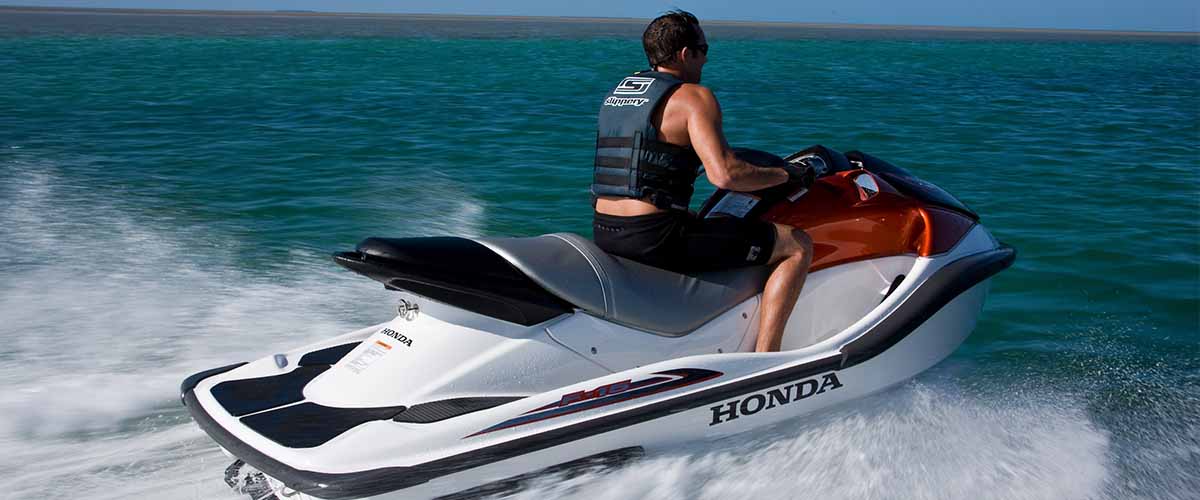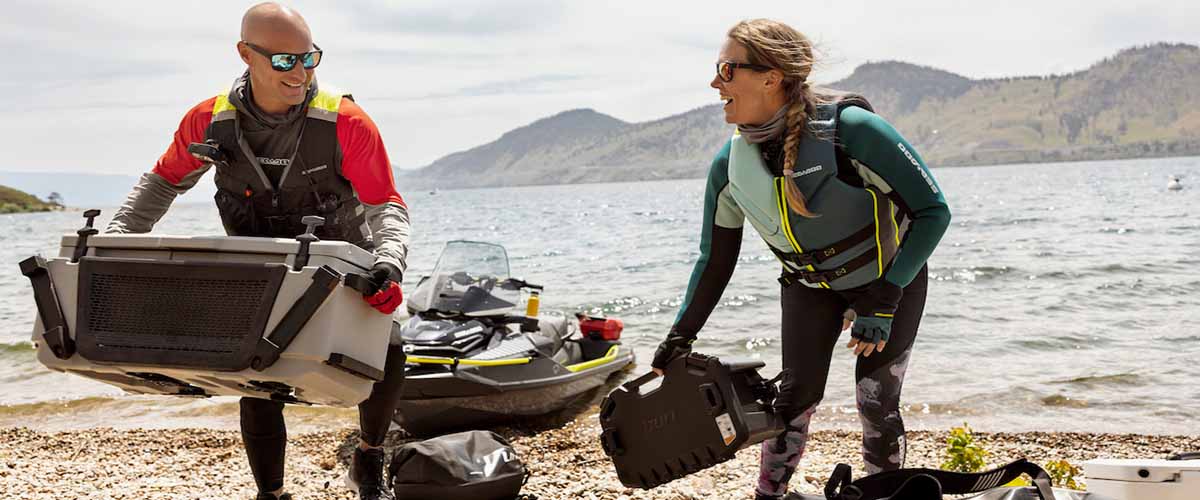2002-2006 Sea-Doo GTX 4-TEC Specs and Review [Video]
The 2002 Sea-Doo GTX 4-TEC was the first 4-stroke Sea-Doo in history. It was powered by a 1503cc, 4-stroke, 155 HP Rotax engine and shared its all-new platform with the last generation 2-stroke GTX DI. By 2003, Sea-Doo had released the 4-stroke GTX with a more powerful, supercharged engine.
If you want to learn all about this early 4-stroke Sea-Doo, you’ve come to the right place.
We at JetDrift have compiled all you need to know into this Sea-Doo GTX 4-TEC review!
Sea-Doo GTX 4-TEC Review
Sea-Doo revealed its flagship 3-seater runabout, the GTX, in 1993. Over the years, the 2-stroke GTX line underwent many different generations, including:
- 1993 Sea-Doo GTX 580 (Rotax 587)
- 1994 Sea-Doo GTX 650 (Rotax 657)
- 1995 Sea-Doo GTX 650 (Rotax 657x)
- 1996-1997 Sea-Doo GTX 800 (Rotax 787)
- 1998-2001 Sea-Doo GTX RFI (Rotax 787 RFI)
- 2000-2001 Sea-Doo GTX DI (Rotax 947 DI)
- 2002-2003 Sea-Doo GTX DI (Rotax 947 DI)
But everything changed in 2002 when Sea-Doo decided to bring 4-stroke technology to its fleet. As a result of this effort, the all-new GTX 4-TEC was released for the 2002 model year.
Just like Sea-Doo, Yamaha also introduced its 4-stroke ski for 2002, and both were closely followed by the Honda Aquatrax.
In a nutshell, these early 4-stroke jet skis and their key engine specifications were as follows:
- Sea-Doo GTX 4-TEC: 1,493cc, 3-cylinder, 155 HP
- Yamaha FX140: 998cc, 4-cylinder, 140 HP
- Honda Aquatrax F12: 1,235cc, 4-cylinder, 125 HP
- Honda Axuatrax F12X: 1,235cc, 4-cylinder, turbocharged, 165 HP
Each of these models had its pros and cons, but all of them provided a much quieter and cleaner operation. Also, 4-stroke engines were more fuel-efficient and provided higher durability and reliability.
Unlike the outdated 2-stroke units, 4-stroke power mills didn’t require “carb work” (cleaning, rebuilding) or a periodic top-end rebuild.
In contrast, they were larger, heavier, and much harder to work on.
If you take a closer look at the list above, you can see that the GTX 4-TEC stood out from the crowd with its large-displacement, 1493cc engine. This power source was a 4-stroke, 1503 Rotax in-line triple utilizing many advanced features, including:
- Rotax Multipoint Fuel Injection
- 12 valves (4 valves per cylinder)
- Dry sump oil injection system
- Closed-loop cooling system
- NGK DCPR8ES spark plugs
- Electric starter
Besides 4-stroke technology, another remarkable innovation on the GTX 4-TEC was its closed-loop cooling system. This closed-circuit cooling utilized a special coolant to transfer heat away from the engine while using the ride plate as a radiator.
This revolutionary technology kept saltwater away from the engine, which resulted in less wear and tear and zero salt build-ups in the engine.
Sea-Doo has been using this CLCS (Closed Loop Cooling System) technology ever since, while other manufacturers are still sticking with traditional open-loop cooling for some reason.
Thanks to these advanced features, the naturally-aspirated Sea-Doo GTX 4-TEC produced a whopping 155 HP, only 10 HP less than the turbocharged Aquatrax F12X.
Although the 2-stroke GTX line had received three hull redesigns and many upgrades over the year, the new GTX 4-TEC received an entirely new hull and top deck.
This completely new GTX platform was designed from scratch and engineered specifically for the 1503 Rotax power source. (Despite this, the ’02-’03 2-stroke GTX DI borrowed this new body.)
Compared to the classic GTX, the new deep-V-shaped hull was 6 inches longer, and its depth was increased from 17.5 degrees to 22.5 degrees.
The new top deck, just like the hull, was tailored by Sea-Doo’s award-winning design team.
It not only featured modern curved lines and details but it also came with three separate storage compartments, including a front storage, a glovebox, and an under-seat tray with a spark plug holder.
The total storage capacity of the new GTX was 52.5 gallons – more than twice that of its predecessor.
Riding experience?
The large stable hull of the GTX 4-TEC offered very smooth and predictable rides, even with passengers.
Its innovative deck combined with the integrated “grills” on the front portion of the hull effectively kept water spray away from riders. This resulted in more comfort, better vision, and dry rides.
In the early 2000s, the GTX 4-TEC was one of the most stable 3-seater runabouts in the marketplace. As reported by Boats.com, the ski ran smoothly at high speeds, even on a 2-3-foot chop.
Its top speed was about 56-58 mph, slightly more than its 2-stroke brothers. On the other hand, the 4-stroke engine provided less throttle response and a slower standing-start acceleration.
In addition to the new power source, the ski featured the Sea-Doo-exclusive O.P.A.S. (Off Power Assisted Steering) system.
The O.P.A.S. utilized two rudders mounted on the rear sides of the hull and was controlled by pump pressure. As the name suggests, this system was designed to provide off-throttle steering support.
Standard features of the 2002-2006 Sea-Doo GTX 4-TEC included:
- Handlebar-mounted start/stop button
- Handlebar-mounted function buttons
- Large front storage
- Glove box
- Under-seat storage tray with spare spark plug holder
- Electric start
- Tether cord
- 2 gauges (speedometer, tachometer)
- Fender cleats
- Off-Power Assisted Steering (OPAS)
- Overheating warning device
- Bow and stern eyes
- Ski tow eye
- Bilge drain plugs
- Sponsons
- Rear grab handle
- Manual reverse
- Large, 2-piece seat with a seat strap
- Tool kit
- DESS security system
The large dashboard had an analog speedometer, an analog tachometer, and a small display area with many useful functions. The function (MODE/SET) buttons were mounted on the left handlebar, just below the start/stop button.
The Gauge Functions of the GTX 4-TEC were as follows:
- Clock: Indicates the actual time in hours and minutes (hh:mm).
- Compass: Displays the cardinal point to indicate the orientation of the watercraft.
- Average Speed: The information center approximately calculates and displays the average speed (AV KM/H or AV MPH) of the watercraft since the last engine start.
- Distance: (KM or MILES). The information center approximately calculates the distance based on the operation time and the watercraft speed and displays the result in kilometers (KM) or miles (MILES).
- Hourmeter: Displays the time in hours of the watercraft usage (HOUR).
- Water Temperature: Displays the water temperature (L TEMP) in degrees Celsius (°C) or Farenheit (°F).
- Exterior Temperature: Displays the exterior air temperature (E TEMP) in degrees Celsius (°C) or Fahrenheit (°F).
- Trip Hour Meter: (TRIPMTR) Allows to measure an interval of time in hours and minutes (hh:mm).
Thanks to its innovative engine, stable hull, and advanced features, the GTX 4-TEC became extremely popular among families.
Sea-Doo marketed this model from 2002 through 2006 without any major changes. In 2007 the GTX got a complete redesign.
Sea-Doo GTX 4-TEC Problems
Although it was a really innovative machine, the GTX suffered from some initial design flaws.
Let’s take a closer look at each!
GTX 4-TEC O.P.A.S. Issues
The main idea behind this system was to provide some steering ability in off-throttle situations.
Although the O.P.A.S. was a revolutionary idea, its rudders were easily activated by fluctuating pump pressure on choppy waters. This often resulted in “bumpy” rides, which caused a lot of headaches for riders.
Because of this, many owners eliminated this system with an aftermarket O.P.A.S. block kit.
ECU Issues
Unfortunately, the ECU on the 2002 Sea-Doo GTX 4-TEC models didn’t work properly. To solve this issue, Sea-Doo installed a “DESS amplifier” between the ECU and the DESS key.
Although the manufacturer never issued an official recall, dealers replaced the ECU in all of the skis that visited the dealership for any reason.
These ECU issues were fixed for the 2003 model.
Faulty Crankshaft
The 2002 GTX 4-TEC models also had a bad reputation for their weak crankshaft, which was prone to breaking over time.
Weak Plastic Pump and Cavitation
Another poorly designed part of this ski was the pump housing, which surprisingly was made of plastic.
The driveshaft/impeller misalignments due to the weak pump and driveline caused the wear ring to wear out after a short period of use. The clearance issues around the impeller often led to cavitation issues and poor performance.
Although the wear ring was replaceable, the only real long-term fix to this issue was replacing the pump housing.
Fortunately, Sea-Doo fixed this bug for the 2004 model by using a more durable driveshaft, bearings, and an aluminum pump housing.
2002-2006 Sea-Doo GTX 4-TEC Specs Chart
For your convenience, we’ve compiled the 2002-2006 Sea-Doo GTX 4-TEC specifications into these charts!
2002 Sea-Doo GTX 4-TEC Dimensions
| 2002 Sea-Doo GTX 4-TEC | Dimensions and Capacities |
|---|---|
| Number of passengers | 3 (refer to load limit) |
| Overall length | 331 cm (130 in) |
| Overall width | 122 cm (48 in) |
| Overall height | 113 cm (44 in) |
| Weight | 378 kg (834 lb) |
| Load limit | 272 kg (600 lb) |
| Fuel tank (including reserve) | 60 L (15.3 U.S. gal) |
| Fuel tank reserve | 9.8 L (2.6 U.S. gal) |
| Cooling system (coolant) | 5.5 L (5.8 U.S. qrt) total |
| Engine oil | 3 L (3.2 U.S. qrt) |
2002 Sea-Doo GTX 4-TEC Engine Specs
| 2002 Sea-Doo GTX 4-TEC | Engine Specs |
|---|---|
| Engine type | BOMBARDIER-Rotax 1503, 4-stroke |
| Number of cylinder | 3 in line |
| Number of valve | 12 valves (4 per cylinder) with hydraulic lifters (no adjustment) |
| Exhaust system | Water cooled / water injected with regulator |
| Performance | 155 HP |
| Displacement | 1493 cm3 (91.1 in3) |
| RPM Limiter Operation @ | 7650 RPM ± 50 |
| Bore | 100 mm (3.9 in) |
| Stroke | 63.4 mm (2-1/2 in) |
| Compression ratio | 10.5:1 |
| Cooling Type | Liquid cooled. Closed circuit. (see also exhaust system) |
| Coolant | Ethylene-glycol 50%/50% antifreeze/water. Coolant containing corrosion inhibitors for internal combustion aluminum engines |
| Fuel injection | Rotax EMS (engine management system). Multipoint Fuel Injection. Single throttle body (52 mm (2.04 in)) |
| Lubrication type | Dry sump (2 oil pumps). Replaceable oil filter. Water-cooled oil cooler. |
2002 Sea-Doo GTX 4-TEC Liquids
| 2002 Sea-Doo GTX 4-TEC | Liquids |
|---|---|
| Fuel type | Regular unleaded gasoline with 87 octane |
| Coolant | Ethylene-glycol 50%/50% antifreeze/water. Coolant containing corrosion inhibitors for internal combustion aluminum engines |
| Oil type | 4-stroke engine oil SAE 10W40 (API service classification SG, SH or SJ) |
2002 Sea-Doo GTX 4-TEC Propulsion
| 2002 Sea-Doo GTX 4-TEC | Propulsion |
|---|---|
| Propulsion system | Bombardier Formula pump |
| Jet pump type | Axial flow, single-stage. Greased bearings. |
| Reverse system | Yes |
| O.P.A.S. system | Yes |
| Pivoting angle of direction (nozzle) | ~ 20° |
| Minimum required water level for jet pump | 90 cm (3 ft) |
2002 Sea-Doo GTX 4-TEC Electrical Features
| 2002 Sea-Doo GTX 4-TEC | Electrical Features |
|---|---|
| Magneto generator output | 360 W @ 6000 RPM |
| Ignition system type | Digital inductive type |
| Spark plug - Make and type | NGK, DCPR8ES, Quantity: 3 |
| Spark plug - Gap | 0.75 mm (.030 in) |
| Starting system | Electric starter |
| Battery | 12 V, 30 Ah, Electrolyte type |
| Fuse - TOPS | 10 A |
| Fuse - Cylinder 1, ignition coil and injection | 10 A |
| Fuse - Cylinder 2, ignition coil and injection | 10 A |
| Fuse - Cylinder 3, ignition coil and injection | 10 A |
| Fuse - Electric bilge bump (optional) | 3 A |
| Fuse - Starting system, electric fuel pump | 10 A |
| Fuse - EMS, start/stop circuit | 5 A |
| Fuse - Main | 2 X 30 A |
| Fuse - MPEM | 2 A |
| Fuse - Charging system | 20 A |
| Fuse - Information center | 1 A |
These charts are for informational purposes only! For exact specifications, please refer to the factory manual.
Vintage Sea-Doo GTX 4-TEC for Sale
If you are considering purchasing one, you probably want to know where to find a Sea-Doo GTX 4-TEC for sale. As this model vanished from the market in 2006, it’s already a collectible item, so finding one is not an easy task!
We recommend that you start your research on dedicated Sea-Doo forums and Facebook fan groups. Aside from some good deals, you may find some valuable info there about this ski.
Besides these sources, you may also find some used Sea-Doo GTX 4-TECs for sale on Craigslist, PWC Trader, and other dedicated jet ski swap sites.
Takeaway
As a takeaway, we’ve answered the most common questions about the 2002-2006 Sea-Doo GTX 4-TEC!
What is a Sea-Doo 4-TEC?
The Sea-Doo 4-TEC refers to the manufacturer’s 4-stroke technology, introduced in late 2001.
What is a Sea-Doo GTX 4-TEC?
The 2002 Sea-Doo GTX 4-TEC was the first 4-stroke Sea-Doo PWC in history, followed by the supercharged GTX 4-TEC SC in 2003.
What Year did Sea-Doo Make the GTX 4-TEC?
Sea-Doo marketed the first-generation GTX 4-TEC from 2002 through 2006. By 2007, the model had been completely redesigned with more advanced features.
Was a Sea-Doo GTX 4-TEC a 2-Stroke Ski?
As the name suggests, the Sea-Doo GTX 4-TEC utilized a 4-stroke engine.
What was the Difference Between a Sea-Doo GTX and GTI?
Sea-Doo’s GTI family was considered the entry-level line, while the GTX models were the flagship 3-seater runabouts. The latter were heavier and more stable, providing predictable and comfortable rides. In contrast, the smaller GTI models were more nimble and affordable.
What Size Storage Compartments Did a Sea-Doo GTX 4-TEC Have?
The Sea-Doo GTX 4-TEC featured a small glove box, a large front bin, and an under-seat storage tray, with a total storage capacity of 52.5 gallons.
How Many People Could Ride a Sea-Doo GTX 4-TEC?
The Sea-Doo GTX 4-TEC was rated for three riders.
What Size was the Sea-Doo GTX 4-TEC?
The Sea-Doo GTX 4-TEC was 130 inches long, 48 inches wide, and 44 inches high.
How Much Did a Sea-Doo GTX 4-TEC Weigh?
The dry weight of the Sea-Doo GTX 4-TEC was 834 pounds.
What Kind of Engine Did the 2002-2006 Sea-Doo GTX 4-TEC Have?
The engine of the 2002-2006 Sea-Doo GTX 4-TEC was a 4-stroke Bombardier-ROTAX 1503. This 1493cc, SOHC triple featured a closed-loop cooling system and a Multipoint Fuel Injection system.
How Much Horsepower Did a 2002-2006 Sea-Doo GTX 4-TEC Have?
The 2002-2006 Sea-Doo GTX 4-TEC provided 155 HP at 7,650 RPM.
Did the Sea-Doo GTX 4-TEC Have Reverse?
Yes, the Sea-Doo GTX 4-TEC was equipped with manual reverse.
How Much Weight Could a Sea-Doo GTX 4-TEC Hold?
The total weight capacity of the Sea-Doo GTX 4-TEC was 600 pounds.
How Much Fuel Did a Sea-Doo GTX 4-TEC Hold?
The Sea-Doo GTX 4-TEC utilized a 15.9-gallon (60 L) fuel tank.
How Much Fuel Did a Sea-Doo GTX 4-TEC Use?
The fuel consumption of the Sea-Doo GTX 4-TEC was about 10.8 GPH at WOT.
Could the Sea-Doo GTX 4-TEC Tow a Skier or a Wakeboarder?
Yes, the Sea-Doo GTX 4-TEC was rated for three riders, so it could legally tow a skier or a wakeboarder.
How Fast Did a 2002-2006 Sea-Doo GTX 4-TEC Go?
The top speed of a 2002-2006 Sea-Doo GTX 4-TEC was 56-58 mph in stock condition.
How Much is a 2002-2006 Sea-Doo GTX 4-TEC Worth?
It’s hard to tell the exact price of a Sea-Doo GTX 4-TEC, as it strongly depends on its year, condition, and location. But as a rule of thumb, the prices typically range from $1,000 up to $7,000.
DISCOVER 2024 PWC MODELS Kawasaki, Sea-Doo, Yamaha, Krash…








